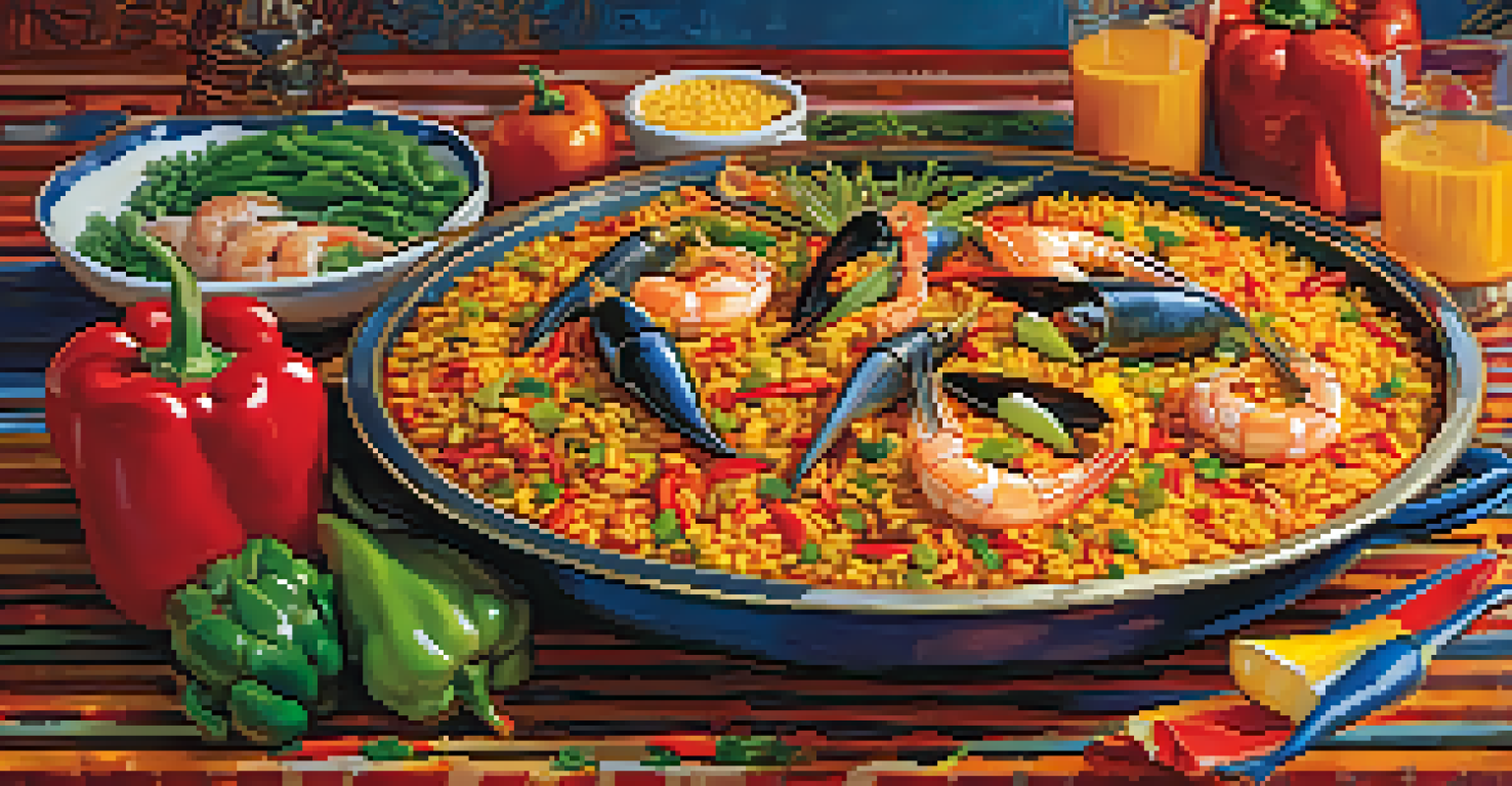Exploring the Aromatic World of Spanish Paprika

A Brief History of Spanish Paprika and Its Origins
Spanish paprika, or 'pimentón', has a rich history that dates back to the 16th century when it was introduced to Spain from the Americas. Over time, it became a staple in Spanish cuisine, influencing dishes across the globe. Regions like La Vera in Extremadura are renowned for their unique drying methods, which contribute to the spice's distinctive flavor.
There is no love sincerer than the love of food.
The cultivation of paprika peppers in Spain is deeply tied to the country's agricultural practices and its climate. The combination of warm temperatures and fertile soil creates the perfect environment for growing these vibrant peppers. This historical journey reflects not just the spice's culinary significance but also its cultural roots in Spanish society.
Today, Spanish paprika is celebrated not only for its taste but also for its versatility. It can be found in traditional dishes like paella and chorizo, showcasing how an ingredient can weave itself into the very fabric of a nation's cuisine.
Types of Spanish Paprika: Sweet, Smoked, and Hot
Spanish paprika comes in several varieties, with the most notable being sweet (dulce), smoked (picante), and hot (agridulce). Each type offers a unique flavor profile, allowing chefs to select the perfect paprika for their dishes. Sweet paprika provides a mild, rich flavor, while smoked paprika adds a depth that is both earthy and aromatic.

Smoked paprika, often called 'pimentón de la Vera', is made by drying peppers over an oak fire, giving it a robust smokiness that can transform any recipe. This variety is particularly popular in Spanish stews and grilled meats, where its flavor can shine. On the other hand, hot paprika introduces a spicy kick that can elevate salsas and marinades.
Rich History of Spanish Paprika
Spanish paprika, or 'pimentón', has evolved from its introduction in the 16th century to become a key ingredient in Spanish cuisine.
Understanding these different types empowers home cooks to experiment and enhance their culinary creations. Whether you're making a traditional Spanish dish or adding a twist to your own recipes, there's a type of paprika that can fit the bill perfectly.
Health Benefits of Spanish Paprika: A Spicy Superfood
Not only does Spanish paprika add flavor to your meals, but it also packs a punch when it comes to health benefits. Rich in antioxidants, it can help combat inflammation and support overall health. Capsaicin, the compound responsible for the heat in some types of paprika, is known for its potential to boost metabolism and aid in weight management.
Cooking is like love. It should be entered into with abandon or not at all.
Additionally, paprika is a good source of vitamins A, E, and B6, which contribute to skin health, immune function, and energy production. Incorporating this spice into your diet is an easy way to enhance both flavor and nutrition. Just a sprinkle can transform a simple dish into a vibrant, health-boosting meal.
As we become more aware of our food choices, spices like paprika offer a delicious path to a healthier lifestyle. It’s a flavorful reminder that we can enjoy our meals while still caring for our bodies.
Culinary Uses of Spanish Paprika: From Dishes to Seasonings
Spanish paprika is incredibly versatile, making it a favorite among chefs and home cooks alike. From seasoning meats and fish to enhancing sauces and soups, it can elevate a wide variety of dishes. For instance, a sprinkle of sweet paprika can add depth to a creamy risotto or a classic deviled egg recipe.
In addition to its role in main dishes, paprika can also be used to create flavorful marinades and spice blends. By mixing it with garlic, olive oil, and vinegar, you can create a delicious marinade for grilled vegetables or meats. This adaptability makes it a go-to spice in any kitchen.
Varieties and Culinary Versatility
Spanish paprika comes in sweet, smoked, and hot varieties, each offering unique flavors that enhance a wide range of dishes.
Furthermore, paprika can be a beautiful garnish, bringing color and a hint of flavor to your plate. Its vibrant red hue not only looks appealing but also hints at the rich flavors waiting to be discovered in every bite.
Storing and Choosing Quality Spanish Paprika
To get the most out of your Spanish paprika, it’s essential to know how to store it properly. Keep it in an airtight container, away from light, heat, and moisture, to maintain its vibrant flavor and color. When stored correctly, paprika can last for up to a year, although it’s best used fresh for optimal taste.
When purchasing paprika, look for high-quality products that are labeled as 'pimentón de la Vera' or 'pimentón de Murcia.' These designations indicate authentic Spanish paprika, often made using traditional methods. Checking for freshness and aroma can also help you choose the best quality, as the spice should have a rich, smoky scent.
Being selective about your paprika can significantly enhance your cooking. Investing a little time in sourcing quality spices can lead to a world of flavor in your dishes.
Pairing Spanish Paprika with Other Ingredients
Pairing Spanish paprika with complementary ingredients can take your culinary creations to the next level. It works wonderfully with garlic, onions, and olive oil, forming a flavor base for many Spanish dishes. The warm, smoky notes of paprika can elevate the taste of roasted vegetables or grilled meats, making them irresistible.
In addition to savory pairings, paprika can also enhance the flavors of certain sweet dishes. It can add a surprising depth to chocolate desserts or fruit salads, creating an intriguing contrast that delights the palate. This versatility shows that paprika isn’t just a one-note ingredient; it can surprise and inspire creativity in the kitchen.
Health Benefits of Paprika
Packed with antioxidants and essential vitamins, Spanish paprika not only boosts flavor but also contributes to a healthier diet.
Experimenting with different combinations can lead to delicious discoveries. Don’t be afraid to get creative and let the paprika shine in both traditional and unexpected ways.
Conclusion: Embracing the Flavor of Spanish Paprika
Spanish paprika is more than just a spice; it’s a journey through history, culture, and flavor. By exploring its different varieties and culinary uses, you can unlock a world of taste that enhances your cooking and delights your senses. Whether you’re a seasoned chef or a home cook, paprika offers endless possibilities.
As you incorporate this aromatic spice into your meals, remember to savor the stories and traditions it carries. Each sprinkle of paprika not only adds flavor but also connects you to the rich heritage of Spanish cuisine.

So, the next time you reach for that jar of paprika, think of it as a passport to a culinary adventure, inviting you to explore the vibrant world of flavors it can bring to your kitchen.